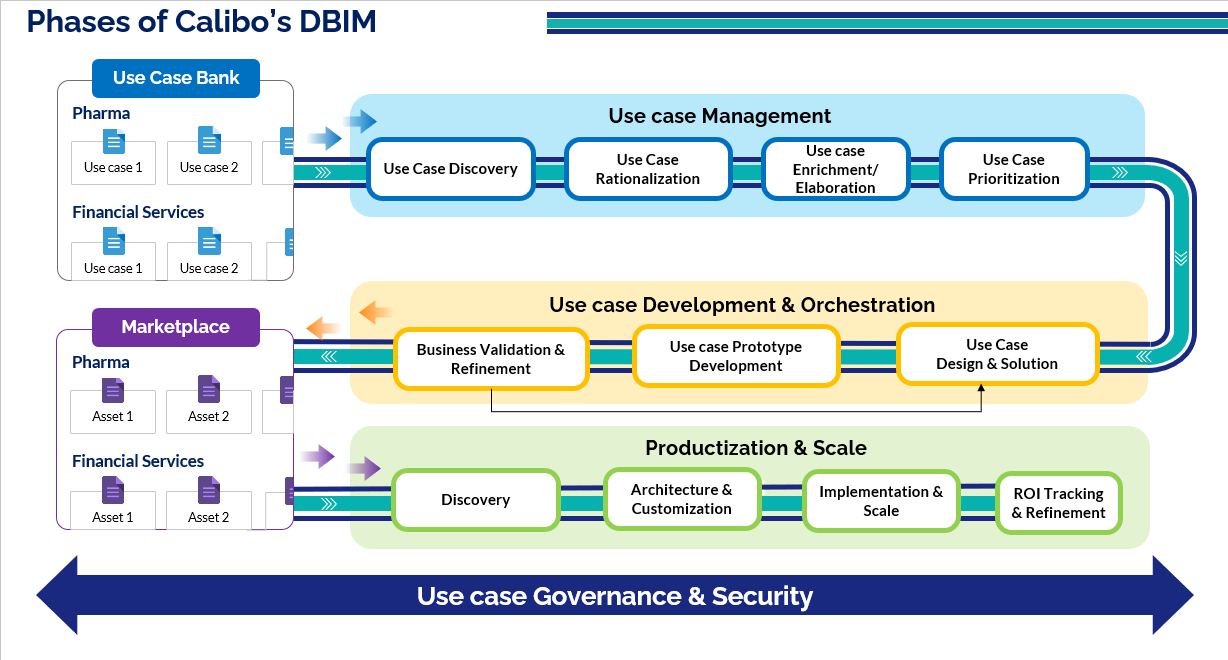Phases of DBIM: From Idea to Impact
Now that we’ve explored the core principles that guide and the Digital Innovation Sandbox that powers Calibo’s Digital Business Innovation Methodology (DBIM), it’s time to dive into how it works in practice.
The three main stages of DBIM are Use Case Management, Use Case Development and Orchestration, and Productization and Scaling. These stages form the foundational pillars of DBIM and are further broken down into multiple phases. Each phase is purpose-built to deliver incremental value, accelerate outcomes, reduce redundancy, and keep your innovation pipeline flowing. Whether you are a domain expert, product owner, engineering leader, architect, or developer, this is your playbook for delivering value at speed and scale.

Note:
In the Productization & Scaling phase, key components such as Use Case Discovery, Architecture & Customization, and Scaling & ROI Tracking are currently being conceptually designed. These capabilities will be available in Calibo Sandbox soon. Stay tuned for future updates.
-
Use Case Bank
The journey starts with the Use Case Bank, a searchable repository that prevents duplication and ensures alignment with business priorities.
See Use Case Bank: Where the Journey Begins. -
Discovery
In this phase, the use case is validated by defining the problem, goals, stakeholders, and strategic alignment. See Discovery: Turning Ideas into Validated Opportunities.
-
Rationalization
In this phase, stakeholders assess each use case for strategic fit, business value, feasibility, and risks—eliminating non-viable ideas early. See Use Case Rationalization.
-
Enrichment
This phase expands qualified use cases into complete specifications, including business, functional, and technical requirements. See Use Case Enrichment and Refinement.
-
Prioritization and Approval
In this phase, scoring models like ICE and WSM are used to prioritize and rank use cases and build a delivery roadmap. See Prioritization and Approval.
-
Development and Orchestration
Converts approved use cases into real solutions through four agile stages:
Define → Design → Develop → Deploy, using Calibo’s Digital Innovation Sandbox and integrated toolchains.
-
Business Validation
After deployment to UAT and Production, live insights feed into the Business Validation & Refinement phase, where performance is evaluated against KPIs and enhancement backlogs are created. See Business Validation and Refinement.
-
Productization and Scaling
Validated solutions move into the Productization and Scaling phase, becoming reusable assets for broader adoption across teams and business units. See Productization, Scaling, and Reuse.
DBIM enables organizations to innovate with confidence—transforming bold ideas into repeatable, enterprise-scale success.
How Advance Bank Embarked on Digital Business Innovation Journey
To illustrate how Digital Business Innovation Methodology (DBIM) comes to life, let’s follow the journey of Advance Bank, a leading financial institution navigating the demands of digital business innovation.
Their story begins with a bold vision from CEO Michael Tan:
“To transform our bank into a data-driven, AI-powered institution that delivers trust, agility, and exceptional experiences across every customer and compliance touchpoint. By investing in scalable digital capabilities—from real-time fraud detection and sentiment analysis to robo-advisors and automated KYC—we will unlock new efficiencies, extend smarter services to the underserved, and lead the future of personalized, secure, and compliant banking.”
But vision alone wasn’t enough. Michael knew success would require orchestration across people, processes, and platforms—and that’s where Calibo’s DBIM came into play.
He assembled a cross-functional team with the mandate to deliver value fast, using DBIM’s structured approach to identify, design, and execute high-impact use cases. Here’s the Advance Bank’s core team driving the transformation:
|
Role |
Stakeholder Name |
Responsibility / Ownership |
|---|---|---|
|
CEO |
Michael Tan |
Defined the strategic direction and empowered the organization to execute with agility. |
|
Chief Digital Officer (CDO) |
Esther Jackson |
Aligned the initiative with broader digital transformation goals. |
|
Chief Product Officer (CPO) |
Martha Grace |
Led the identification of customer experience use cases to support the bank’s product innovation agenda. |
|
Portfolio Owner |
Joseph George |
Prioritized and scoped use cases within the innovation portfolio. |
|
Product Owner |
Maria Lopez |
Owned the selected use case end-to-end—requirements, backlog, and delivery coordination. |
|
Lead Data Engineer |
Vikram Patel |
Designed scalable data pipelines for ingesting and processing customer review data. |
|
Solution Architect |
Helena Chan |
Architected a compliant, scalable solution leveraging the self-service capabilities of Calibo’s Digital Innovation Sandbox. |
|
Compliance Officer |
Amrita Singh |
Ensured GDPR and data privacy compliance across ingestion and processing stages. |
|
Front-End Developer |
Anthony Hanks |
Built user-friendly interactive dashboards to visualize sentiment insights. |
|
Back-End Developer |
Neha Gupta |
Developed API integrations to fetch, process, and display data from various review platforms. |
|
QA Lead |
Eva Lee |
Defined test strategy, managing QA processes, ensuring product quality, coordinating test execution, and validating features before release |
|
Product Release Manager |
Alex Carter |
Coordinated releases and stakeholder communication during deployment cycles. |
|
Release Train Manager |
Sebastian Reagan |
Oversaw delivery timelines, sprint alignment, and release train progress. |
This team’s journey—from discovering the right use case to delivering real business outcomes—provides a narrative thread through each phase of the DBIM framework. As we explore these phases, you’ll see how structured innovation at Advance Bank turned ideas into assets and strategy into scalable solutions.
What follows is a detailed walkthrough of each phase, starting with the Use Case Bank, where ideas are captured, organized, and prepared for evaluation. Think of it as the entry gate to your innovation journey.
|
What's next? Use Case Bank: Where the Journey Begins |